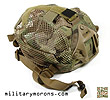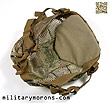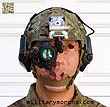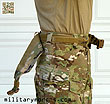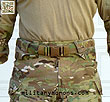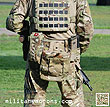CRYE PRECISION PAGE 1 PAGE 2 PAGE 3 PAGE 4 PAGE 5 PAGE 6 PAGE 7 PAGE 8
TO VIEW FULL SIZE IMAGES: USERNAME and PASSWORD are both "mm"
Crye Precision Nightcap and Skullcap
Nightcap - The Nightcap is designed as a compact, head-worn night vision goggle mount that takes the place of the issue 'skull crusher' head mount, for when the user does not want to wear a helmet and doesn't want the bulk of the issue head mount. The problem with the issue head mount is that it's awkward to carry when not in use and it has limited adjustability, as far as angle or NOD height goes. The Nightcap allows the use of mounts like the Norotos or Wilcox that have all the necessary adjustments incorporated into them. No other headmount folds up flat and stuffs into a shirt or pant pocket like the Nightcap. At first glance, Crye's Nightcap looks like someone stuck a NOD shroud on the front of a brimless mesh baseball cap, and I wondered how on earth that would support the weight of a night vision device. The Nightcap is primarily made of Omega polyester mesh. Omega is a high tear strength matrix with 2mm hole diameter that offers high breathability and camouflage. If you look at night vision head mounts, you'll see that they mostly share common load paths obtained by the use of straps. The Nightcap does the same, but by using the mesh fabric in combination with webbing to provide the support for the NOD. The 'heart' of the Nightcap is the shroud base. The Ops-Core VAS shroud is used as the NOD mount with a three-hole pattern. At the front of the Nightcap is a cordura pocket, which houses a shaped carbon fiber insert. The mounting screws of the VAS shroud go through this insert as well as the cordura in the front and back, providing a secure mounting platform. Right behind the insert is another pocket that folds out and is held in place by a velcro strip. This pocket has a soft microfiber fabric for next-to-skin comfort, and houses a removable foam forehead pad. The combination of carbon fiber insert and pad distributes the pressure over a wider area. A 1.5"-wide webbing headband encircles the head except for at the back, where the rear adjustment is. Circumference adjustment is made by tightening or loosening the 3/4" webbing strap at the back with ladder lock. This snugs the front pad and shroud against the fore head.
The strap system is similar to the Ops-Core Head-Loc retention system/harness. The key to the stability of the Head-Loc system is that the side straps are straight, all the way from the back of the head to the front of the chin, while the chin straps are also straight when they run from the side of the Nightcap and down under the chin. By eliminating the angle or pivot points between the chin cup and straps, the system is more stable on the head than conventional helmet or head mount harnesses. The straps are attached to metal loops, sewn to the 1.5" wide head band. Strap adjustment is accomplished by triglides. Instead of a quick-release plastic buckle for donning and doffing, a simple snap and metal D-ring arrangement reduces bulk and doesn't interfere with cheek weld when firing a rifle.
The Nightcap features two velcro adjustments on top of the head. Right above the shroud mount is a metal loop through which a velcro strap runs through and secures back on top of the Nightcap. Shortening or lengthening this loop adjust the cap from front to back. The runs over the top of the head and down to the back. Crossing this strap at the top are two velcro one-wrap tabs. These are used to bring the sides of the mesh cap closer together at the top. By using the front-back and side adjustments, the Nightcap can accommodate different size head depths/heights. Shortening the straps raises the cap higher. Lengthening them lowers the cap. The velcro straps also provide a means of routing cables and attaching IFF squares. A 3.75" x 2" loop velcro patch is sewn to the back of the cap for counterweights etc. Nightcap with NODs - Adjustments to the height of the Nightcap using the velcro tabs and strap on the top of the cap should be done initially without NODs attached. The Nightcap is then donned, and the headband tightened via the strap at the back. The side straps are then snugged up with the triglides. As you can see in the photos below, the Wilcox mount installs directly into the VAS shroud and it's closer to the head than when mounted to helmet. The Nightcap also allows hearing protection headsets to be worn over it and seal properly over the ears - something that some other semi-rigid head mounts don't. You can see how low profile and compact the Nightcap is when worn. By the way, ignore the plastic clip hanging off the PVS-14; it's part of the Down Range Gear lanyard system (which can also be installed on the Nightcap). Chin straps can be snugged up and adjusted after the NVG is attached as there'll be some slight shifting due to the added weight.
I was surprised at how solid the Nightcap feels, once all the straps are tightened and it's adjusted properly. Like a helmet, it does require that the straps are snugged to prevent movement. With a PVS-14 installed and no counter weight, it obviously feels front-heavy. A helmet may distribute the weight better, but then you have the additional weight of a helmet on your head. Compared to the USGI night vision head mount assembly, I found the Nightcap more comfortable, mainly due to the front forehead pad spreading out the pressure better than the thin pad of the USGI head mount. There are other NVG headmounts available on the market in addition to the USGI skull crusher, but I haven't tried any of them. While some, like the Ops Core Skull Crusher might offer more comfort for extended use, none of them will be as compact and packable as the Nightcap. I can literally fold up the Nightcap and fit it inside the shoulder pocket of a Crye Field shirt. Skullcap - The Crye Skullcap is a low profile, fleece lined beanie with a smooth MultiCam outer shell. The MultiCam fabric is a printed fleece that is not yet available to the commercial market, but it a smooth outer face fabric laminated to a soft, low nap microfiber fleece. The Skullcap is low profile enough to be worn under a helmet, and is shaped to cover the ears without extending too low and getting in the way of the eyes. The smooth outer surface helps repel water and block wind while still remaining breathable. There are two small slits on the side as pass-through slits for eyewear temples. After using the Skullcap, I'm guessing that most folks won't utilize the slits, as they don't work with eyewear that have retaining straps, and you have to take the little extra time to insert the eyewear temples through the slits after donning the cap. Also, if you forget they're passed through and you grab the Skullcap to take it off, the eyewear comes off as well. Other than that, it's a comfortable, warm and low profile beanie.
|
Crye Precision Modular Riggers Belt
/ . PLEASE
OBSERVE AND RESPECT OUR COPYRIGHT! . /
©opyright by MilitaryMorons.com. All Rights Reserved. Reproduction, Duplication,
Distribution Strictly Prohibited.
Unless mentioned otherwise, content and images are the
property of militarymorons.com and are not in the public domain.
They are not to be used without
permission. Please Contact
me for permission to use any images or content herein.
